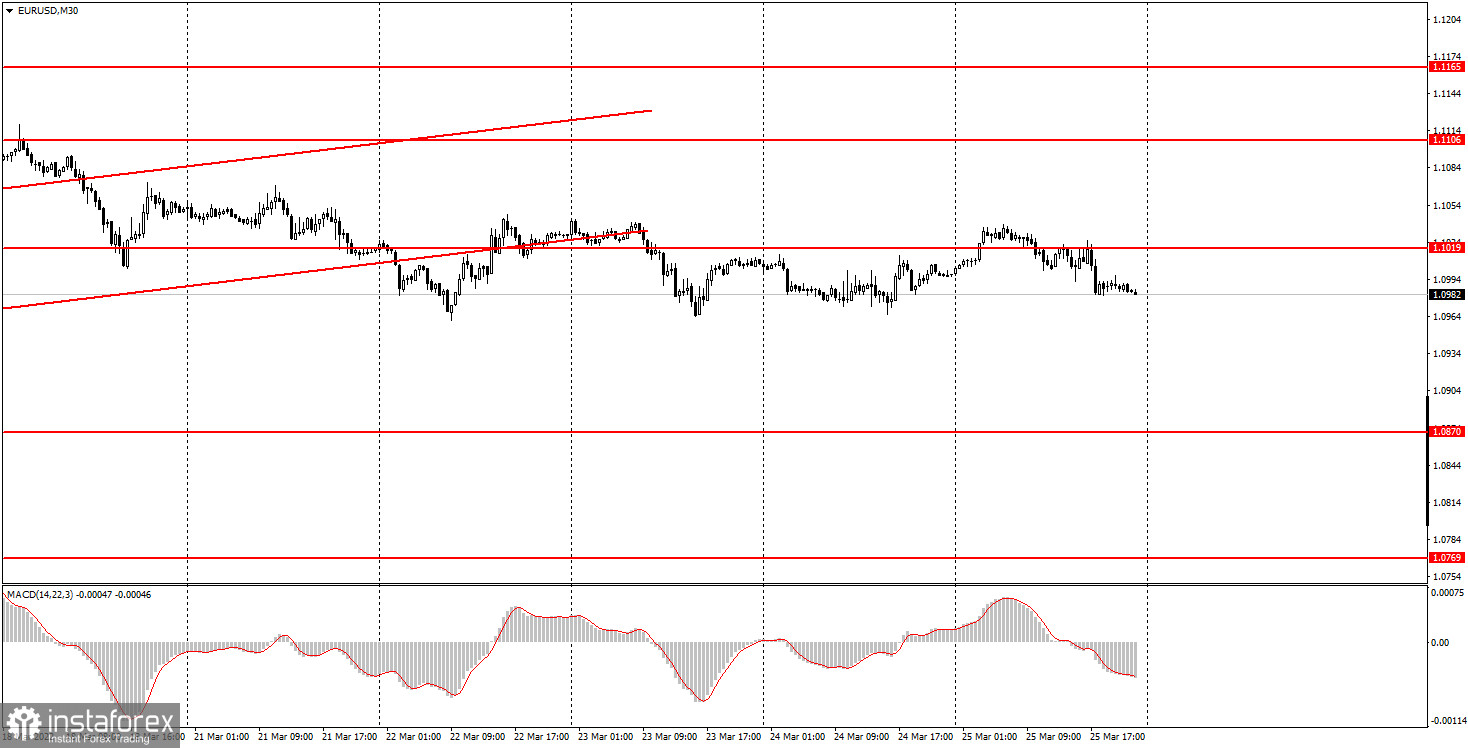Analysis of previous deals:
30M chart of the EUR/USD pair

The EUR/USD currency pair was in a total flat on Friday. Volatility was slightly less than 60 points, which is not so little for the euro currency. However, over the past month, the market has accustomed us to much higher volatility. Therefore, now 60 points a day look very weak. In principle, there was even a certain downward movement during the day. However, the 30-minute TF also shows very clearly that the pair has spent the last four days between the levels of 1.0966 and 1.1038. Of course, this can hardly be considered a horizontal channel, although why not? We haven't put these levels on the chart yet. Nevertheless, we advise novice traders to watch them at the beginning of a new week. The most important thing to understand now is that the foreign exchange market has calmed down. Calmed down after a month of rather volatile and active movements. The geopolitical factor has finally begun to fade into the background, but it can return to the first at any time if the situation in Ukraine or other "hot spots" of the world escalates. Neither the United States nor the European Union published a single important report on Friday, there was not a single important event. Thus, weak movements are explicable.
5M chart of the EUR/USD pair

The technical picture does not look like a full flat on the 5 minute timeframe, due to its small scale. However, all trading signals were formed only around one level (1.1019), and none of them led to the target level being reached. Thus, the signs of a flat are still there. At the beginning of the trading day, it was unclear exactly how the pair would move during the day. Therefore, novice traders could work out the first two trading signals. First, a blatantly false buy signal was formed when the price bounced from the level of 1.1019, and then a sell signal when the price overcame 1.1019. In the first case, the pair could not go up even 10 points. In the second case, the price initially dropped by 11, then by 20 points with a preliminary rebound from 1.1019. Therefore, the first trade closed at a small loss, and the second - at breakeven on Stop Loss. In general, Friday, like this whole week, was not the best time to trade. After the pair moved very volatile for a month, the "bad days" came. Now the main thing is that this kind of movement does not persist next week.
How to trade on Monday:
On the 30-minute timeframe, the pair has consolidated below the ascending channel, so we still expect to see a continuation of the fall. However, so far everything is going to the fact that the price will be stuck for some time in the horizontal channel of 1.0966-1.1038. There is also a high probability of a drop in market activity, which can lead either to idling or to very weak trend movements. On the 5-minute TF tomorrow, it is recommended to trade by levels 1.0902, 1.0932, 1.0966, 1.1019, 1.1038, 1.1070, 1.1106. When passing 15 points in the right direction, you should set the Stop Loss to breakeven. Neither the US or the EU is scheduled for any important event or report on Monday. There hasn't been much news on geopolitics lately either, so most likely tomorrow newcomers will have nothing to pay attention to, and the pair will trade with low volatility.
Basic rules of the trading system:
1) The signal strength is calculated by the time it took to form the signal (bounce or overcome the level). The less time it took, the stronger the signal.
2) If two or more deals were opened near a certain level based on false signals (which did not trigger Take Profit or the nearest target level), then all subsequent signals from this level should be ignored.
3) In a flat, any pair can form a lot of false signals or not form them at all. But in any case, at the first signs of a flat, it is better to stop trading.
4) Trade deals are opened in the time period between the beginning of the European session and until the middle of the American one, when all deals must be closed manually.
5) On the 30-minute TF, using signals from the MACD indicator, you can trade only if there is good volatility and a trend, which is confirmed by a trend line or a trend channel.
6) If two levels are located too close to each other (from 5 to 15 points), then they should be considered as an area of support or resistance.
On the chart:
Support and Resistance Levels are the Levels that serve as targets when buying or selling the pair. You can place Take Profit near these levels.
Red lines are the channels or trend lines that display the current trend and show in which direction it is better to trade now.
The MACD indicator (14,22,3) consists of a histogram and a signal line. When they cross, this is a signal to enter the market. It is recommended to use this indicator in combination with trend lines (channels and trend lines).
Important speeches and reports (always contained in the news calendar) can greatly influence the movement of a currency pair. Therefore, during their exit, it is recommended to trade as carefully as possible or exit the market in order to avoid a sharp price reversal against the previous movement.
Beginners on Forex should remember that not every single trade has to be profitable. The development of a clear strategy and money management are the key to success in trading over a long period of time.
 English
English 
 Русский
Русский Bahasa Indonesia
Bahasa Indonesia Bahasa Malay
Bahasa Malay ไทย
ไทย Español
Español Deutsch
Deutsch Български
Български Français
Français Tiếng Việt
Tiếng Việt 中文
中文 বাংলা
বাংলা हिन्दी
हिन्दी Čeština
Čeština Українська
Українська Română
Română

